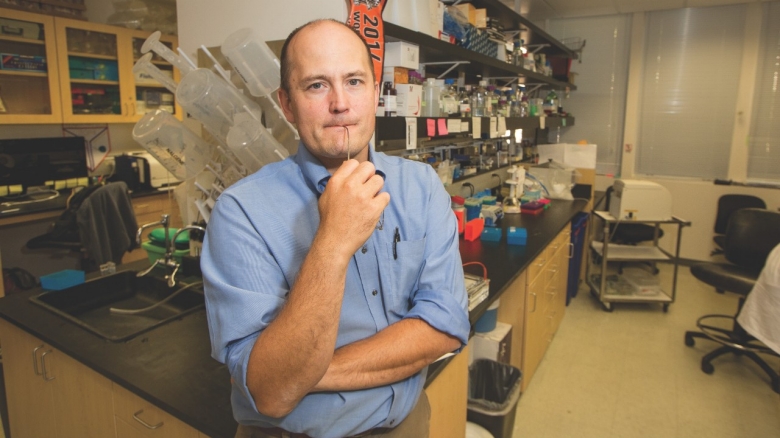
Paul Bollyky, MD
New Plays to Tackle Inflammation and Infection

Paul Bollyky, MD
New Plays to Tackle Inflammation and Infection
It’s a natural—and usually beneficial—response of the human body to react to a wound or pathogens with angry, red swelling. A sore knee or stomach, while an annoyance for anyone, is a sign that the immune system is sending all its molecular soldiers to defend and repair an injury. But, around the world, there are times the immune system falters, letting infectious diseases take their toll on populations. Likewise, there are times the immune system becomes a belligerent, over-responsive army—lashing out at the body it’s meant to defend when there’s nothing to attack. In both cases, clinicians have struggled to develop ways to treat these conditions; the immune system is complex and has many unknowns.
Now, a new generation of researchers, including fresh faces in Stanford’s Division of Infectious Diseases, are coming at the immune system, as well as invading pathogens, with new energy and new approaches. Their research has implications for conditions as common as diabetes and as globally far-reaching as tuberculosis.
In 2013, Paul Bollyky, MD (assistant professor, Infectious Diseases), launched his lab at Stanford to understand how the body responds to wounds and infections. He homed in on a molecule called hyaluronan, found in the nooks and crannies between cells, as being vital to mediating immune responses.
“You make hyaluronan in abundant quantities at the sites of injuries,” Bollyky explains. “If you’ve ever twisted your ankle or gotten a bad burn, all that swelling and edema is basically caused by hyaluronan.” The molecule, he’s found, recruits both water and immune molecules to injuries. And blocking hyaluronan, his research team recently reported in the Journal of Clinical Investigation, can control chronic inflammation—the kind that’s not benefitting the body at all.
It’s a natural—and usually beneficial—response of the human body to react to a wound or pathogens with angry, red swelling. A sore knee or stomach, while an annoyance for anyone, is a sign that the immune system is sending all its molecular soldiers to defend and repair an injury. But, around the world, there are times the immune system falters, letting infectious diseases take their toll on populations. Likewise, there are times the immune system becomes a belligerent, over-responsive army—lashing out at the body it’s meant to defend when there’s nothing to attack. In both cases, clinicians have struggled to develop ways to treat these conditions; the immune system is complex and has many unknowns.
Now, a new generation of researchers, including fresh faces in Stanford’s Division of Infectious Diseases, are coming at the immune system, as well as invading pathogens, with new energy and new approaches. Their research has implications for conditions as common as diabetes and as globally far-reaching as tuberculosis.
In 2013, Paul Bollyky, MD (assistant professor, Infectious Diseases), launched his lab at Stanford to understand how the body responds to wounds and infections. He homed in on a molecule called hyaluronan, found in the nooks and crannies between cells, as being vital to mediating immune responses.
“You make hyaluronan in abundant quantities at the sites of injuries,” Bollyky explains. “If you’ve ever twisted your ankle or gotten a bad burn, all that swelling and edema is basically caused by hyaluronan.” The molecule, he’s found, recruits both water and immune molecules to injuries. And blocking hyaluronan, his research team recently reported in the Journal of Clinical Investigation, can control chronic inflammation—the kind that’s not benefitting the body at all.
Bollyky’s basic findings have the potential to treat autoimmune diseases like multiple sclerosis, characterized by inflammation of the nervous system. And they also may revolutionize the prevention of something far more common: type 1 diabetes. In patients with this autoimmune disease, inflammation of the pancreas is an early precursor to more severe symptoms. Blocking the hyaluronan, and therefore the inflammation, Bollyky thinks, could slow the progression of the disease.
But while treating inflammation is one lofty goal, diagnosing infectious diseases can be just as tricky. Jason Andrews, MD (assistant professor, Infectious Diseases), is tackling this challenge. He’s developing and evaluating low-cost diagnostic tools that can be used in settings like rural Nepal where electricity, water, and high-tech laboratories are hard to come by. These include an electricity-free, culture-based incubation and identification system for typhoid and an easy-to-use molecular diagnostic tool that does not require electricity. With his technology in development, Andrews is continuing epidemiologic research on diseases like tuberculosis to get a better handle on how they spread and what weak spots in their transmission cycles might lend themselves to intervention.
Bollyky’s basic findings have the potential to treat autoimmune diseases like multiple sclerosis, characterized by inflammation of the nervous system. And they also may revolutionize the prevention of something far more common: type 1 diabetes. In patients with this autoimmune disease, inflammation of the pancreas is an early precursor to more severe symptoms. Blocking the hyaluronan, and therefore the inflammation, Bollyky thinks, could slow the progression of the disease.
But while treating inflammation is one lofty goal, diagnosing infectious diseases can be just as tricky. Jason Andrews, MD (assistant professor, Infectious Diseases), is tackling this challenge. He’s developing and evaluating low-cost diagnostic tools that can be used in settings like rural Nepal where electricity, water, and high-tech laboratories are hard to come by. These include an electricity-free, culture-based incubation and identification system for typhoid and an easy-to-use molecular diagnostic tool that does not require electricity. With his technology in development, Andrews is continuing epidemiologic research on diseases like tuberculosis to get a better handle on how they spread and what weak spots in their transmission cycles might lend themselves to intervention.
